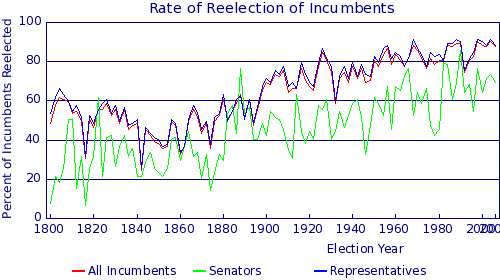This graph is from GovTrack’s Representative Statistics, showing the rate at which federal representatives have been reelected. Note that Senators were appointed by state legislatures up until 1913, when the 17th Amendment went into effect.

I wonder: Are our congressmen 90% better than they were 150 years ago? Or are our district boundaries 90% worse? Are we electing our congressmen? Or are they selecting their constituents?
Last night I finished reading Edward Tufte’s “The Visual Display of Quantitative Information.” Consequently, I must apologize for every graph I’ve ever made. I’ll do better.
In reference to these statistics on incumbency,I thought about the case of Iowa, with its non-partisan redistricting plan and whether or not the seats were more competitve. First as explained the website you got the stats from, these statistics only count changes in office holders. So I went to wikopedia and mined this data out. If you count it that way Iowa’s seats have changed office holders 18 times in 70 elections since the plan was applied in 1982 (Iowa has 5 seats currently, they had 6 till 92, when they lost it to the 90 census) You can discount 4 of these changes since it was because the Reps swapped seats during the 1990 & 2000 redistricting. Of the remaining 14, 7 were retirements, but the same party held the seat in the subsequent election. There were 7 seats that flipped in elections, 4 of them over open seats and 3 were contested elections (of which 2 were in 06). The Senate seats flipped only once when Harkin beat a GOPer that got caught going to a massage parlor, and claimed he thought it was a “health club”. The other question is whether or not this has increased Iowa’s voter participation level. I got this from the Iowa board of elections:
2004 78%
2002 56%
2000 72%
1998 55%
1996 71%
1994 62%
1992 86%
1990 65%
1988 75%
1986 59%
1984 82%
1982 67%
How this compares with Iowa before the plan or Virginia or the general US I don’t know, I may go looking if I have the time
To answer part of my own question:
Virginia and Iowa, side by side:
Iowa Virginia
2004 78% 71%
2002 56% 39%
2000 72% 69%
1998 55% 33%
1996 71% 74%
1994 62% 69%
1992 86% 85%
1990 65% 45%
1988 75% 77%
1986 59% 42%
1984 82% 82%
1982 67% 64%
So as you can see, for the most part, Iowa and Virginia perform comparably during Presidential elections, but for the most part Virginia turns out fewer voter in off years. The glaring exception is 1994 the year of the Robb/North race.
Very interesting!
>>Edward Tufte’s “The Visual Display of Quantitative Information”
Maybe it’s just that I’m a bit of a stats nuts, but that is just one of the best.books.ever. Didn’t it come out about 20 years ago? It’s stuck with me ever since.
It’s an old one, but definitely a good one. I have the second edition, which I understand contains only the most mild of updates. I hope to move directly to “Envisioning Information” next, followed by “Visual Explanations” and then his latest, “Beautiful Evidence.”
What you have done is to help make the case for term limits.
On my own blog, I have been running a little four part series on our aristocracy of lawyers. Consider ramifications of the limited scope of the skills of our leaders. Then consider the ever expanding scope of the responsibilities of our government. Are we not led by a bunch of people whose primary expertise resides in persuasion and their understanding of the rules? What qualifies these people to keep all the promises they make?
Like any other group of people our legal aristocracy likes to make their lives easy and secure. They are also very ambitious. So they have used their understanding of the rules and their powers of persuasion to secure their positions and to increase their power and influence, and that is about all they have accomplished.
When they no longer have the ability to respond correctly to events, societies crumble. A major part of society’s adaptability comes from its ability to elect responsive leadership. Unfortunately, our legislators have become nearly impossible to fire. At the same time, our government continues to grow in size. Government is not noted for it agility — or efficiency. The private organizations our government displaces are far more adaptable and efficient. As we have progressed towards socialism, we have slowly set ourselves up for disaster.
Sorry to post here I can’t find your email. Was wondering why you dropped me?
Cheers
I wasn’t aware I’d picked you up in the first place. This calls for E-Mail Man and More Words Man!
finally getting some upsets man :-p